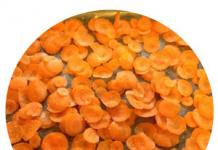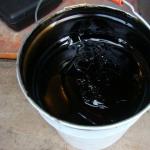The most important condition in the process of drying vegetables and herbs is the circulation of warm air. In order for the air to take away moisture, it must be constantly dry, but not too hot. In this case, everything will dry correctly, with minimal loss of vitamins and essential oils.
But it is these substances that determine the aroma of dried seasonings, and ultimately the taste of the finished food.
Air drying
Vegetables can only be dried outdoors in dry weather, as drying requires low humidity.
The best way to dry herbs is in a well-ventilated shed, in an attic with active ventilation, or on an open balcony. The greens are dried in small bunches, which are tied in one row to a rope so that they are ventilated on all sides.
Roots (parsley, celery, carrots) cut into small pieces or thin strips, as well as sweet and hot peppers, are dried on large sieves that are easy to make yourself. Finely chopped vegetables are laid out on them. The sieve is hung in a well-ventilated place, and the vegetables are mixed several times a day.
Drying in oven and electric dryer
In the fall, when it is no longer possible to dry vegetables in the fresh air, this can be done in the oven.
Pieces of vegetables are laid out on retractable racks, previously covered with parchment paper. Vegetable slices can also be strung on stainless steel rods or knitting needles.
During drying, the oven door should be slightly open so that moist air does not stagnate inside.
When using electric dryers, the main rule is not to overload the sieves, but fill them loosely with pieces of vegetables so that air can easily penetrate between them.
Drying rules
All vegetables intended for drying must be ripe, clean and undamaged. They need to be dried as soon as possible after collection, before they darken. The chopped vegetables are laid out in one layer.
At the same time, preliminary quick boiling of vegetables greatly facilitates drying and further cooking with them.
The drying process is complete when the vegetables and herbs feel fragile to the touch.
Store dry products in a dark place, at a temperature no higher than +15° C, in tightly closed glass jars or in thick paper bags.
We dry it correctly!
Carrots are cut into equal pieces, 5 mm thick or longitudinal slices, 2 cm long. Drying time is 6 hours.
 Celery is cut into strips or cubes and dried at +60° C. The greens are tied into bunches and dried in the fresh air, and then ground and added to spice mixtures with salt.
Celery is cut into strips or cubes and dried at +60° C. The greens are tied into bunches and dried in the fresh air, and then ground and added to spice mixtures with salt.
The onion is cut into rings 5 mm thick and placed in a loose layer to dry in the oven (separate from other vegetables). Dry for about 5 hours.
Green chives are simply cut off and dried at +60° C.
The white part of leeks is used for drying. This “stem” is divided into individual leaves and then cut into pieces. Lay out in one layer. Dry for 5 hours.
Before drying, garlic bulbs are disassembled into cloves, peeled, cut into small strips and laid out to dry in a loose layer (dries in about 5 hours). Dried garlic can be ground into powder and mixed with salt.
 Hot peppers for drying can be strung on thin twine and hung in a dry place. In the future, it can be ground into powder or left in pods. The small pods are dried in the oven for about 6 hours. Please note that the most bitterness is contained in the seeds.
Hot peppers for drying can be strung on thin twine and hung in a dry place. In the future, it can be ground into powder or left in pods. The small pods are dried in the oven for about 6 hours. Please note that the most bitterness is contained in the seeds.
The tomatoes are small and quite dense. They are cut in half or into 4 parts, placed on a sieve or on a wire rack covered with parchment paper, skin side down. They are ready when they feel leathery to the touch (about 8 hours), although they can be dried longer.
Greens for spicy mixtures are air-dried in bunches or on paper, spread out in a loose layer. In the oven, the greens are dried at a temperature not exceeding +35 ° C. The coarse stems of the dried greens are removed, and the leaves are lightly ground and stored in jars in a dark, cool place.
Based on materials from the magazine “Lyubimaya Dacha”
A great way to prepare vegetables for the winter is to dry them. Such fruits can be used to prepare various dishes. You can dry vegetables by placing them on sieve or trays and exposing them to the sun's rays. You can easily determine their readiness by eye.There is one more method of drying vegetables- in the oven. In another way it is called artificial drying. If you want to use it, line a baking sheet with parchment paper and place the prepared fruits on it. Place the baking sheet on the top shelf of the preheated oven, leaving the door ajar. After 20 minutes, move the baking sheet with vegetables down and dry them until ready.
You can check whether the fruits are ready by two signs. If vegetables release juice (no matter in what quantity) and the pieces break when compressed, the raw materials are not completely dried.
Dried vegetables practically do not contain vitamins, which evaporate along with moisture during heat treatment. This is their main drawback.
Before you start drying, select quality vegetables. Unripe and overripe ones are not suitable for this.
Special requirements are imposed on the preparation: if you want to dry legumes, take unripe, so-called milk fruits.
If you decide to dry whole vegetables, pay attention to their size. It is desirable that they are all approximately the same size.
Rinse the vegetables thoroughly, and then dilute 0.5 tablespoons of vinegar in 0.5 liters of water and dip the vegetables intended for drying into the solution. This way you will wash away any remaining pesticides from the fruit.
After cutting the skins off the vegetables, wash them again and chop them. To prevent crushed fruits from darkening, dip them in a saline solution for a few seconds. Vegetables cut into strips or slices dry much faster.
If you want to dry your greens, tie them into bunches and hang them on string or string in a well-ventilated area.
In order to prepare white roots (, and parsnips), wash them, peel them and cut into thin slices. Place them on a baking sheet lined with parchment paper and place in the oven. Dry the roots at a temperature of 60°C, opening the lid slightly and checking their readiness from time to time.
Root vegetables intended for drying should have a bright color and a small diameter. Prepare them by washing and removing the skin.
Do you want to dry light-colored vegetables as quickly as possible while maintaining their original color? Place the prepared fruits in an enamel pan, 1/4 of the total volume filled with liquid sugar syrup, and place over medium heat. After 5 minutes, remove the vegetables from the stove, place them in a colander to drain the liquid, and start drying them.
 After this, place the peeled root vegetables in a pan of water brought to a boil. Blanch the carrots for 10-15 minutes. Drain the water without removing the vegetables and place the pan under cold running water. Wait until the carrots have cooled, then cut them into strips about 3 cm long and place them on a baking sheet. Place it in the oven, preheated to a temperature of 80 - 85°C, and make sure that the vegetables do not burn.
After this, place the peeled root vegetables in a pan of water brought to a boil. Blanch the carrots for 10-15 minutes. Drain the water without removing the vegetables and place the pan under cold running water. Wait until the carrots have cooled, then cut them into strips about 3 cm long and place them on a baking sheet. Place it in the oven, preheated to a temperature of 80 - 85°C, and make sure that the vegetables do not burn.
If you want to dry, choose only spicy varieties. Clean the heads from the scales, cut out the bottoms, cut the onions into rings and place on a baking sheet. Remember that onions can only be dried in an oven preheated to a temperature of 65 °C.
In order to preserve the original taste and aroma, dry its leaves entirely. After thoroughly washing the leaves, tie them into bunches and hang them on a rope outdoors under a canopy or in a draft.
Before putting dried vegetables into storage, carefully inspect them so that poorly dried vegetables do not accidentally get into the general mass, as mold may appear on them.
Store dried vegetables in a cool, dry place, placing them in glass jars and sealing them tightly with metal lids.

Drying vegetables is more convenient and profitable than canning. You can use your usual cooking utensils or a special dryer.
To dry or not?
Definitely dry it. Because this is a very profitable and inexpensive way to prepare vegetables for the winter. When dried, vegetables retain much more nutrients than frozen or canned foods. The blanks take up little space and do not require special storage facilities.
Not everyone can afford to consume canned foods for health reasons: after all, such preparations, as you know, use an increased amount of salt, sugar or vinegar. Dried vegetables do not have this disadvantage. And you don’t need to bother with spices, marinades and other ingredients of the rather labor-intensive and tedious canning process.
Drying vegetables is beneficial not only to those who have a dacha or a house in a village with abundant harvests of vegetables and herbs. Even if you just bought a few kilograms of vegetables at the nearest market or picked a few baskets of mushrooms in the forest - dry them. And during the long winter or vitamin-free spring, you will delight your family with wonderful salads, soups or pies. After all, it is enough to simply soak dried vegetables in cold water before cooking.
How to dry?
Under the sun. The easiest way to dry. For different vegetables and herbs, drying time varies and can range from several hours to several days. But this method is suitable if you live outside the city in clean air, the days are sunny and you have a lot of free time. You can turn over, shake chopped vegetables on a metal sheet and hide them in time from an unexpected downpour.
In the oven. A simpler and more convenient way of drying. In this case, the vegetables are laid out on baking sheets and placed in a gas or electric stove. Set the minimum temperature (usually 50-60 degrees). If there is, select the blowing and ventilation mode.
In a convection oven or microwave oven. This is several times faster than oven drying. However, portions of vegetables will be smaller. And energy consumption is most likely higher.
In the vegetable dryer. However, it is most profitable to dry vegetables, herbs and mushrooms in a specialized device. Vegetable dryers can be of two types - electric dryers and infrared dryers. The principle of operation of an electric dryer is to supply air heated to a certain temperature by a fan built into the device. An infrared dryer works on different principles: moisture is absorbed by electromagnetic waves.
Device selection
What features should you consider when purchasing a vegetable dehydrator?
1. Power. The higher it is, the faster the drying process occurs.
2. Location of the heating element. It's better if it's on the top. If the heating element is placed at the bottom, water (condensation) may get on it.
3. Temperature adjustment. Allows you to select the optimal mode for each product.
4. Number of pallets. More the better. You can dry more products at the same time.
The lack of natural vitamins acutely affects the human body in the winter season. Lack of sun and fresh food leads to weakened immunity, vitamin deficiency and an increased risk of contracting ARVI diseases. However, modern technologies make it possible to obtain a sufficient amount of useful elements even in the cold season - for example, from fruits dried for future use. Today we will look at how you can eat vegetables at home, how to prepare them, how to properly store and eat such products.
Advantages and disadvantages of this method
Drying is a very popular way to store and prepare supplies on your own for the winter. However, this method has both positive aspects and disadvantages.
Pros
- long-term storage of fruits;
- saving space when storing the finished product;
- for the most part, preservation of the beneficial properties and vitamins of the fruit;
- simplified harvesting process, in comparison with seaming;
- the possibility of long-term storage of dry fruits and fruits (in comparison with canned ones);
- ease of use of dried products, preservation of their taste and nutrients;
- the ability to dry those fruits that are not suitable for pickling.

Cons
The disadvantages of this process are:
- significant loss of weight and volume of the finished fruit - they lose up to 90% of their mass;
- some loss of vitamins and beneficial properties of the product - the fruit loses up to 30% of its minerals and vitamin C;
- due to loss of moisture, the fruits become dry, sometimes hard, which complicates the process of cooking them in the future;
- the drying process is not suitable for all fruits;
- Preserving dried products is problematic - mold often spoils the fruit.
Did you know? Scientists date the invention of this storage method as drying back to the Neolithic era - about 9000 BC. e. Due to global cooling, the ancient inhabitants had to stock up on food for future use, which is why they were forced to dry roots, and some in reserve.
What vegetables can be dried
The range of products suitable for drying for the winter is quite wide. It is noteworthy that only healthy fruits that are not susceptible to disease are suitable for harvesting. Only those parts of the product that are edible are dried - without tops or roots.  Almost everything can be dried - from to. Drying is popular, and it makes a wonderful preparation for borscht. Delicious dried chips are made from it, and dried herbs add freshness and flavor to dishes during the cold season. Dried and acquire a peculiar piquancy when dry, which reveals the taste of dishes in a new way.
Almost everything can be dried - from to. Drying is popular, and it makes a wonderful preparation for borscht. Delicious dried chips are made from it, and dried herbs add freshness and flavor to dishes during the cold season. Dried and acquire a peculiar piquancy when dry, which reveals the taste of dishes in a new way.
It is noteworthy that preparation methods such as preservation and pickling do not preserve the beneficial properties of the product and do not provide benefits to the body due to the use of salt and. When drying, no additional spices or oils are used, which preserves the taste and vitamin composition of the product. Dried vegetables are a kind of concentration of all the beneficial properties that exist in their fresh counterparts.
Traditionally, the drying method is not used for those vegetables that consist of more than 85% water, since when harvested in this way they lose a lot of weight and productivity becomes very low. These include:

Preparing vegetables for drying
It is best to dry seasonal products - at this time they are less susceptible to chemical treatments and retain the maximum amount of vitamins and useful minerals. When harvesting from your own plot, it is best to use 2-3 harvests of vegetables - such fruits acquire juiciness and pronounced taste. It is best to use strong, healthy fruits without damaged skin or rot.
- . It is worth choosing late varieties of vegetables, since these types contain the largest amount of starch. It is desirable that the fruit has a thin skin, smooth, without eyes or pits - this will not reduce productivity. The tubers are thoroughly washed in cold water, then the fruit is peeled. Before drying, peeled and chopped portions of potatoes must be kept in boiling water for 3 minutes and then cooled in cold water. Potatoes cooked this way retain their nutrients. The potatoes are now ready to dry.
- Beet. Fruits are selected with a bright, rich color - this indicates ripeness and juiciness. wash in cold water, then boil for 25 minutes. After the beets have cooled in cold water, they need to be peeled and cut into portions for drying.
- . The best fruits for harvesting are smooth, with a bright color. Preliminary preparation is carried out as for beets, only the cooking time is reduced to 15 minutes. In order to preserve as much of the nutritional properties of this fruit as possible, it is better to use the blanching method for its preparation.
- . For proper drying, it is necessary to remove all leaves, stalks and damaged areas. Divide the inflorescences into small sections, rinse them well and immerse them in salt water for 10 minutes (this will rid the product of caterpillars and). Then you need to blanch the fruit in hot water for 25 minutes. Now the cauliflower is ready to dry.
- and horseradish. The roots are washed well and allowed to dry. Grate on a coarse grater and dry in an electrical appliance. Dried horseradish needs to be ground into powder. It is noteworthy that during the drying process, horseradish loses its aromatic properties by 70%.
- . This fruit is dried entirely, and the seeds and stalks are removed from the finished, dried fruit.
- . Sweet peas are used for preparation. As preparation, the method of blanching in hot water is used - 1–2 minutes for small peas, and 3 minutes for large ones. After this procedure, the peas are quickly cooled in cold water and allowed to dry. Now the product is ready for drying.
- . Spicy herbs such as basil, mint, arugula, etc. are the most favorable material for drying. First, the greens must be rinsed in cold water, removing dust and dirt from the leaves. It is advisable to use young shoots. Roots and damaged leaves must be removed. Clean grass is cut into pieces, laid out on the surface and dried naturally.
- . The vegetable must be washed in cold water, the hard parts are cut off, and allowed to dry. After this, the pods are strung on a thread - now the asparagus is ready for drying in the oven.
- . It is better to choose fruits that are round, thin-skinned, and have a uniform skin color. The cleaned one is also boiled in boiling water for 10 minutes, and after that they proceed directly to drying it.









Blanching and steaming
Blanching- a method of heat treatment of a product in which the specific unpleasant odor and bitterness of the vegetable are eliminated. The process involves briefly immersing the fruit in boiling water (boiling usually lasts no more than 10 minutes). Steaming is the process of exposing food to hot air released from boiling water. This procedure is carried out to disinfect the product and destroy unnecessary bacteria.
If previously housewives used mainly ovens and the sun to dry vegetables and fruits, today modern technology provides a lot of electric ovens and dryers, which will allow you to prepare the product in the shortest possible time, preserving its beneficial properties. Let's take a closer look at each harvesting method.
Outdoors
This method has more disadvantages than advantages. First of all, not everyone has the opportunity to dry produce in the open air - vegetables laid out in a row require a lot of space and a flat surface, otherwise the drying process cannot be carried out. Also, with this harvesting method, there is a high probability of damage to the fruit by midges, or the secreted juice of the product is a bait for insects.
It is also difficult to keep track of the drying process - a strong scorching sun can turn the juicy pulp into coals, and sudden rain can completely ruin the product. Don’t forget to stir and turn the fruits to dry them evenly. The main disadvantage of the method is the duration of the process - up to 4 days, which significantly reduces the quality of finished supplies.  This method is only good for greens - the sun and fresh air will quickly turn the grass into dry powder. It is important to ensure that no moisture gets on the drying grass. It is also not recommended to place greens under the scorching rays - in this case, the grass and leaves will quickly burn. Shade in hot, dry, windless weather is best for drying.
This method is only good for greens - the sun and fresh air will quickly turn the grass into dry powder. It is important to ensure that no moisture gets on the drying grass. It is also not recommended to place greens under the scorching rays - in this case, the grass and leaves will quickly burn. Shade in hot, dry, windless weather is best for drying.
In an electric dryer
This method is the most convenient and modern - you can dry the fruits in a special device in a few hours. In addition, the fruits are evenly heated from all sides, thanks to the air convection function. There is a rule that speeds up the process of preparing vegetables in: the fruits should be laid with the skin down, and the pulp can be slightly pressed to speed up the process of releasing liquid.
As a rule, electric dryers for home use are small in size, which makes them easier to transport and operate. Some models are equipped with an additional grid with a fine mesh - it is designed for drying particularly small fruits, such as, etc. As a rule, the optimal temperature when drying in an electrical appliance is - from +40 °С to +60 °С.

In the oven
This method of drying vegetables in the oven also has its advantages and disadvantages. This method is called artificial. It became popular due to the availability of available appliances - today almost every housewife has ovens in the kitchen.
In order to use the oven as a dryer, you need to cover a baking sheet with parchment paper, place the prepared vegetables on it, place the baking sheet on the top shelf and turn on the oven to the minimum temperature. The door must be open. After 25 minutes, you need to move the vegetables down and dry until ready.
Please note: if the preparations continue to release juice in the oven, it means they have not yet dried. If the fruit breaks during compression, this also indicates that the supplies are not ready.
The disadvantage of this method of preparation is the need to dry vegetables in several approaches - if you dry them in the oven at once, they will become like crackers. Therefore, vegetables are usually cooked in this way for 2-3 days.  It is recommended to use an electric oven for processing.
It is recommended to use an electric oven for processing.
Important! The temperature in the oven when drying vegetables should not exceed +60° C. Otherwise, the fruits will burn or become overdried.
In the microwave
Drying vegetables in the microwave is also gaining popularity. The main trick of this method: The thinner a fruit or vegetable is cut, the faster it will dry out. The disadvantage of this processing method is the impossibility of harvesting a large number of fruits - therefore, this method is convenient only when you need to quickly dry a small amount of product.
Electromagnetic vibrations in a microwave oven allow you to quickly heat and dry the product, which makes this method the fastest of the above. In addition, the faster the vegetable material is processed, the fewer beneficial vitamins have time to “evaporate” from it. It is noteworthy that if the fruit is cut more than 2 cm thick, microwaves passing into it lose up to 50% of their power - this significantly reduces the speed of cooking supplies.  Also, microwave processing of the product is carried out evenly, in contrast to oven drying.
Also, microwave processing of the product is carried out evenly, in contrast to oven drying.
Did you know? Prepared dried vegetables can be consumed dry. However, it is possible to restore their fleshiness: by soaking the fruit for 2-3 hours in water. The taste of the fruit will differ from the original product.
How to properly store dried vegetables at home
The main rule for storing the finished dry product: prevent dampness and moisture from getting into dried vegetables. Therefore, the best storage method is to preserve the dried product in glass jars with a closing lid, or in food-grade plastic containers. The main thing is to ensure that the container is well sealed to prevent air from entering (moisture particles in the air can affect the quality of the dry product).
Please note: dry products cannot be stored in a plastic bag - this will provoke the appearance of mold. Do not forget to periodically review supplies, throw away spoiled fruits, and dry softened vegetables, if necessary.
You can recommend this article to your friends!
64
times already
helped
04 11.15
In this article I will tell you what drying fruits and vegetables is at home. It’s easier than salting and pickling, and much more vitamins will be preserved.
It is best to dehydrate seasonal foods because they are fresh, affordable, and not loaded with chemicals.
In summer and autumn there is a wide variety of fresh fruits, it would be a shame not to take advantage of this. You can even dry watermelons.
But even in winter there is something to prepare - bananas, oranges, persimmons... I really love dried bananas, I eat them with pleasure, for example, with tea instead of sweets.
By the way, we sometimes take discounted bananas in large quantities and fill our dryer with them to capacity)
Types of drying
In an electric dryer

I dry it in an electric dryer. Before purchasing, we researched which one was better. We bought one of the cheapest options and realized that there was no point in overpaying for this product.
By the way, my dehydrator is even present in the design of the blog (it is visible only on wide screens). Who found it?
In the air

Living in Vietnam (photo above from our balcony there), we saw many times how locals put fruit on the roof. We also took advantage of the weather conditions and dried a delicious eggplant appetizer. By the way, would you like to know the recipe?
In Russia, this drying method is not popular for obvious reasons.
If you have such an opportunity, for example, it’s a hot day and you’re at the dacha with a harvest, then feel free to cut your plants into thin pieces and place them outside under the scorching sun. You can also hang it on strings.
Don't forget to turn your dried fruits and vegetables. And watch the sky so that they do not end up in the shadows or get caught in the rain.
In the oven

This is a very common method, but, alas, not the most successful.
Firstly, not all ovens have low temperatures. Secondly, there is often no airflow. Thirdly, they say gas ovens are completely harmful.
However, even if you have the most ordinary oven, you can still dry it.
Slice thinly, place on a wire rack, you can line it with baking paper. Next, turn on the minimum temperature, blowing if available. Be sure to stir or turn over from time to time.
The stove is gas or there is no airflow - open the door. If the temperature is too high, then stir more often, make sure it doesn’t burn, periodically turn off the oven so that the temperature drops a little.
On battery
It is used, of course, only during the heating season. Otherwise it is similar to drying outdoors.

Peeling and slicing
A very important, literally fundamental stage. Try to cut thinly, approximately equally. The thicker the piece, the longer it takes to dry. And if the pieces are different, then dehydration will occur unevenly, which will bring you additional trouble.
Blanching and steaming

Some vegetables need to be blanched before drying, i.e. they should be placed in boiling water for 3-5 minutes, just be careful not to overcook them.
If you are afraid that too many microelements will be lost during cooking, you can keep the vegetables in a double boiler for several minutes. Don't have a steamer? It doesn’t matter, a saucepan + colander will save you.
You should blanch:
- Green beans
- Beetroot
- Broccoli
- Carrot
- Cauliflower
- Green peas
- Potato
- Spinach
Storage

First, dried foods must cool completely. Then you need to pack it in an airtight, moisture-resistant container. These can be thick plastic bags with a zipper, after filling which excess air should be squeezed out.
In addition to bags, you can use glass or plastic jars with a tight-fitting lid.
Store in the dark, cool and dry. Be careful not to expose yourself to direct sunlight.
Reconstruction of dried products

Despite the fact that many fruits are very fun to nibble in dried form, including outside the home or even on a hike. You can rejuvenate them by soaking them for 15-30 minutes and then adding them to baked goods, stews and other dishes. Or, just eat and drink the liquid (I think you tried this with dried apricots).
Dried fruits and dried vegetables are good to use in soups, compotes... For soup, you can pre-soak vegetables. Although, when I was camping and cooking over a fire, we didn’t pre-soak anything, it didn’t spoil the dish at all.
Preparing marshmallows (figs)
It is essentially dried fruit puree. Like dried bananas, figs are great for tea and snacking outside the home.

Making pastille is very simple. We take fresh or even overripe fruits, remove the crust and seeds, cut them and throw them into a blender for grinding. Add a little water or juice, honey or other sweetener, but this is not necessary for juicy sweet fruits.
Experiment, try different combinations, for example, strawberry + banana, peach + pineapple, orange + pineapple, raspberry + apple, banana + coconut, mixed berries, apple + cinnamon. Add nuts - they are absolutely delicious and satisfying.
Vegetable chips
Thinly slice fruits such as zucchini, eggplant, and cucumber. Salt, pepper, use your favorite seasonings and herbs. Dry until the vegetables become crisp. Bon appetit!
Vegetable and mushroom powders

Mushroom soup, vegetable sauce...mmm...yummy.
Dry finely chopped or pureed products until brittle. Then immediately grind in a blender. Don't forget to blanch those vegetables that require it.
Drying nuts
Personally, I get tired of washing nuts every time before eating, and I also don’t like eating them when they are wet. What about you?
There is a solution - rinse several portions at once, put them in an electric dryer. This will take from 2 to 6 hours. The stock of clean dry nuts is ready.
Drying time

The time depends on many factors, such as the moisture content of the food, the size of the pieces, the drying method, air humidity, and the density of the product, so there is no universal figure. Below I have created a table with the main products and the approximate dehydration time in the electric dryer.
The power of most dryers is low, so even if you have to dry for 36 hours, little electricity will be consumed.
I present to you a table with approximate drying times. And below it is a funny video, so watch the article to the end;)
| PRODUCT | Qtyhours |
| apple
| 5-6 |
| apricot | 12-36 |
| banana | 8-38 |
| berries (cut strawberries) | 8-26 cherry 8-34 |
| grape | 8-38 |
orange  | 8-16 |
| peach | 10-34 |
| pear | 8-30 |
| green beans | 8-26 |
| beet | 8-26 |
| broccoli | 6-20 |
| cabbage
| 6-14 |
| carrot | 6-12 |
| cauliflower | 6-16 |
| celery | 6-14 |
| eggplant | 6-18 |
| pumpkin | 6-18 |
| garlic | 6-16 |
| hot pepper
| 6-14 |
| onion | 8-14 |
| mushrooms | 6-14 |
| peas | 8-14 |
| sweet pepper | 4-14 |
| potato | 6-18 |
| tomato | 8-24 |
| zucchini | 6-18 |
spinach  | Did you like the article? Share with friends





















